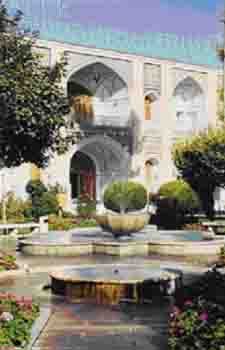|
Under
the Patronage of H.E. Sheikh Nahayan Mubarak Al Nahayan
|
The
Emirates Natural History Group, Al Ain Chapter, PO Box
18057, Al Ain
December, 2004– Issue #223 |
|
| Set the scene: A warm
summer’s day, August 10th of this year, London,
Natural History Museum. I’m sitting on a bench in
one of the many named corridors, with hundreds of people
going by in front of me in both directions. Some sit down
next to me for a brief break before resuming the walk
past the exhibits, among them dinosaur fossils, and explorations
of evolution and Darwin’s theories, just to name
two. From my vantage point I absorb the atmosphere, watch
the faces of those on the go and all along the day’s
events are stuck in my mind with the rewind button in
constant use and the scenes being played over and over
again. As the scenes unfold anew, names are drifting from
the mouths of the ‘players’ and more than
once I find myself clasping the book on my lap bearing
one of the names.
Prior to this day my encounter with
the name had been from the literature, more specifically
some papers published in the former Fauna of Saudi
Arabia, now aptly named Fauna of Arabia.
The papers had been manuscripts desc-ribing and recording
bees and wasps from the Arabian Peninsula. The man who
had written these papers was called Kenneth Guichard
and during the course of the morning I had learnt a
lot about him from the staff at the Entomology department,
and specifically people in the Hymenoptera section (bees,
wasps, saw-flies, ants and other related groups). I
gathered that this entomologist had inspired many other
people to become enthused about ‘bugs’,
such as Ian Hamer, a name I had frequently seen in our
archival material on the ENHG website. Ian Hamer wrote
copious notes for the Bulletin that preceded
the official ENHG journal Tribulus. Hamer collected
much material in the UAE. He retired some years ago
and subsequently wanted to find a home for his collection.
George Else, a hymenopterist at the museum specialized
in bees, was delighted to visit him at his home in North
London and collect the many specimens in 2001, now incorporated
into the Natural History Museum collection.
Chatting to George I learnt more about
both men, and whilst talking, George turned to a cupboard
and pulled out a soft-bound book and handed it to me
– it was a copy of Guichard’s autobiography,
written in the last few months of his life, repeatedly
encouraged to do so by George. I was pleasantly surprised
and with the author’s connection to the Middle
East, George was happy to part with a second copy, along
with an obituary and list of Guichard’s publications
for our library. Guichard was resourceful and as a self-taught
entomologist he earned a living by spotting good paintings
and etchings, bought them and then re-sold them at incredible
prices. He apparently had a flair for this business,
and on one occasion spotted a Stubbs which made him
a hefty sum! His travels took him to many places, including
Oman. In the book he talks about some of the destinations.
Most of the narrative is in the form of poems or short
stories. His manner was not liked by all and another
hymenopterist confessed ‘He was a bloody awful
fellow, but his skills were amazing. A very thorough
man.’
|
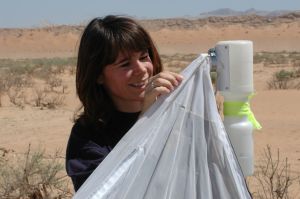 Brigitte
attending the malaise trap.
photo
B. Reimer
Brigitte
attending the malaise trap.
photo
B. Reimer |
|
‘He was a bloody awful fellow,
but his skills were amazing. A very thorough man.’
|
|
|
|
| This broadsheet is published free to families in
the Al Ain area. If you are a member planning an activity with a natural
history theme please notify us so that others can join you. Everybody
is able to contribute to ENHG and Emirates recordings. For more on
our activities please visit our website <www.enhg.org> or join
our e-mail discussion group at ENHG@Yahoogroups.com. The Group meets
at 7.30pm on the 2nd & 4th Tuesday of the month, usually at the
Intercontinental Hotel. New Members are welcome. |
|
---------------------------------------------------------------------------------------------------------------------------------
| The ENHG
Newsletter…
December, 2004– Issue #223
|
|
|
So why was I at the museum in
the first instance? My purpose at the museum
was to seek help with identification of materials we had collected
over the year using a mercury vapour light that had been kindly
lent to ENHG by ERWDA (Environmental Research and Wildlife
Development Agency). Although ERWDA use their equipment continuously,
Chris Drew allowed us to take away the generator and light
set-up whenever we asked for it. The result is that we have
now built up a substantial collection of insects, together
with a much better understanding of seasonality, behaviour,
and diversity of insects in this region. Insects are numerous
and to know something about every insect order is almost impossible
so the help given by the museum has been essential to the
tedious and slow process of putting names to specimens found.
In return, we donate specimens to the museum collection and
over the past three years we have deposited about 100 specimens,
all of them including ENHG on the data label. ENHG has been
able to afford a set-up of our own so this work continues
and although we return on a monthly basis to Wadi Tarabat,
we have also visited many other sites and are going to be
able to draw comparisons between the different habitats. The
ultimate aim is to be able to record insects without having
to collect much more material but to use our reference collection
that will include specimens verified by museum staff. Our
collection recently ‘doubled’ as a result of Mike
Gillett’s donation of his collection to ENHG. The ENHG
collection is the largest of its kind in the UAE and it is
hoped that eventually it will be placed in a more suitable
home.
Earlier this year we hosted the Inter-Emirates
Weekend and one of the evening events included light trapping.
That evening we collected an insect not previously recorded
in the UAE. The insect is commonly known at a mantisfly, though
this name is somewhat misleading. The insect belongs to the
Order Neuroptera (Family Mantispidae) and so is closely related
to ant-lions and lacewings. Using the museum collection I
was able to tentatively identify the specimen as being Mantispa
nana, of which there were some at the museum, collected
in Oman by Larsen. Larsen has published extensively on the
butterflies of Arabia and so it was no great surprise to find
butterfly scales on the matisfly on closer inspection! Mantispidae
have interesting habits! The young are predators in the egg
sacs of spiders, draining egg contents through a sucking tube.
Just before leaving the UAE, Mike’s son Conrad Gillett
visited him. Conrad prepared an artistic painting of the insect
(see picture).
During workshop sessions at Al Ain English
Speaking School (AAESS) the collection will be made available
for viewing. It is also an opportunity for anyone who has
an interest to become involved. The best entomologists have
always been those who are self-taught (e.g. Guichard). In
addition, the collection is now extensive and help would be
appreciated. And whilst at the workshop, remember to glance
at the autobiography.. it is quite revealing!
‚ |
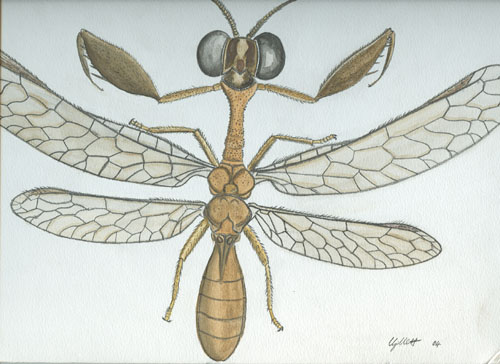 Conrad Gillett’s
illustration of the Mantispidae found in the U.
A. E.
Conrad Gillett’s
illustration of the Mantispidae found in the U.
A. E. |
|
|
|
|
------------------------------------------------------------------------------------------------------------------------------
| The ENHG
Newsletter…
December, 2004– Issue #223
|
Christmas
Eve in the Desert
|
article
& photos by Will Moore |
|
|
This
annual event is one of the best community activities the ENHG
undertakes. About 5:00 pm on Friday evening people began gathering
in the empty lot in front of the Buraimi Hotel. We headed
out in our various vehicles, 4x4’s and sedan cars, towards
Fossil Valley and the Hanging Gardens on the Mahda road. Shortly
after passing the turn off to the Hanging Gardens a dirt track
led off to the right and we followed it to a lovely location
behind a couple of low hills. Small groups climbed the low
hill, watched the sun set and the moon rise.
|
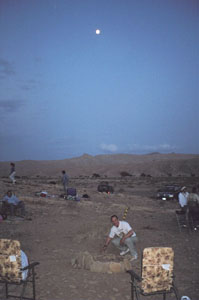 Setting up the firepit in the
moonlight
Setting up the firepit in the
moonlight
|
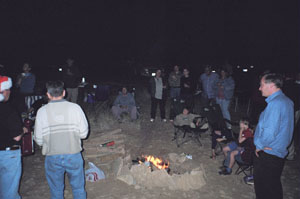
Cooking, gazing, eating, talking, singing, playing... |
|
Here, in the
lee of the wind and out of sight of the highway, 45
– 50 people gathered round a lovely campfire ringed
with stones, precaution-ary windbreak built in and fed
with wood scraps brought from home. A bed of coals quickly
formed and cooking began. Chicken legs, lamb chops,
fish, vegetables, apples and more were put to the coals.
Tables were set up and lamps lit. Coffee, tea, sodas,
juices… all you could ask for to drink. After
repast a bit of Christmas music floated on the air and
a choir formed to sing. Voices, music, children laughing,
people gathered just listening – it was magical.
We carried on into the evening sharing, talking, eating
and making merry in the finest sense of the term.Wrap
up came all too soon, and by 10:00 all were gone, wending
their way out over the flat desert back to the highway
home. A very Merry Christmas to all – and to all
a good night!
MERRY CHRISTMAS folks! |
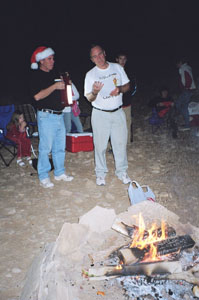
The reading of Khalil Gibran's poetry |
|
|
|
------------------------------------------------------------------------------------------------------------------------------
| The ENHG
Newsletter…
December, 2004– Issue #223
|
Maps
at the Majlis III – something completely different
|
Article
and photos by Bob Reimer |
|
|
November
26th dawned as a clear, crisp morning with temperatures in
the low twenties; an ideal time for a trip to a wadi or the
desert. But 13 ENHG members did something completely different.
We journeyed to the big city of Dubai for a special viewing
of Maps at the Majlis III, the third exhibit of historic maps
of Arabia presented at the Majlis Gallery.
The group set off in five vehicles
from Al Foah ADNOC station at about 9:15 am. Led by Geoff
Cosson, who used to live within 100 metres of the gallery,
we arrived in the Dubai Historic Buildings District with the
convoy intact at 10:30. With a half an hour before our appointed
time, we took the opportunity to take a quick look at the
bastakia buildings and the abra and dhow traffic on the Dubai
Creek. At the gallery we were joined by some folks from Dubai
who had enjoyed the trips at the Music Festival and had followed
our email list with envy since. |
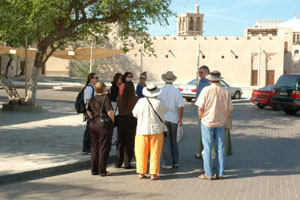 The ENHG at the Dubai historic Buildings site
The ENHG at the Dubai historic Buildings site
|
The Maps
at the Majlis III exhibit consisted of 36 framed
maps as well as several more that were matted and
could be browsed through. The earliest map was a
woodcut map produced in 1540 by Sebastian Munster
showing the Arabian Peninsula as mapped by Claudius
Ptolemy about 150 AD
Representative maps showed
the develop-ment of European understanding of the
shape of Arabia up to recent times with archival
maps from the well known European travellers of
Arabia, Sir Wilfred Thesiger, St. John Philby and
Dame Freya Stark. Fay Huidekoper-Cope, the curator
of the exhibit, presented a lively discussion. She
informed us |
|
|
| about the changes in technology used in map printing
over the centuries from woodcuts through copper engraving to
steel engraving and modern lithography. Using an unmounted map
from the 18th century, she demonstrated how to examine a map
to evaluate if it is an original and if the colouring is old
or modern. The examination started with the back of the map,
showing how it was folded to go in an atlas with a guard strip
of paper on the back to insert it in the binding and still allow
the map to be opened flat. We could also more easily tell from
the back that no repairs had been made to the map and that the
colouring was done in the period the map was printed since the
acids in the green pigment had stained the back. |
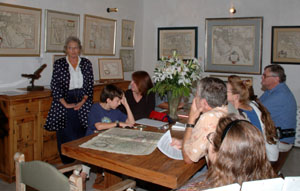 Fay Huidekoper-Cope, the curator of the exhibit,
in the Majlis.
Fay Huidekoper-Cope, the curator of the exhibit,
in the Majlis. |
|
Following
the discussion of cartographic technology, Fay presented some
history of the individual maps, their makers and how the history
of discoveries could be seen with changing map features. It
was a very informative and fascinating presentation.
I’d like to again extend
our thanks to Alison Collins of the Majlis Gallery and Fay Huidekoper-Cope
for opening the Gallery especially for the Al Ain Chapter of
the ENHG on a Friday morning. We really enjoyed the opportunity.
|
|
|
--------------------------------------------------------------------------------------------------------------------------------
| The ENHG
Newsletter…
December, 2004– Issue #223
|
|
|
Maria Theresa’
Silver Dollars
by
Geoff Cosson
Many of our local museums and hotel shops include
collections of jewelry, especially the heavy silver necklaces
which often have coins attached. We saw some on our recent
‘after hours’ Al Ain museum visit. These coins
are almost always the big ‘Maria Theresa’ silver
dollars, which have an intriguing history of their own. |
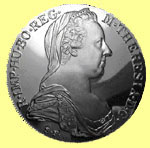 “JD” White coin
“JD” White coin |
|
Why is this Austrian coin so
common? Why does it always bear the same date? A ‘google’
search reveals a story closely entwined with the history
of the Arab world, and the Arabian peninsula in particular:-
a good place to start your research is
< http://www.jdsworld.net/article/m_theresa_thalers.html
> “JD” White has
lovely images there, and more.
The coin is called a ‘thaler’,
taking its name from the silver mines of St. Joachimsthal
in Bohemia, part of the Austrian Hapsburg empire in the
late 18th. century, when Maria Theresa was Empress. In order
to improve her empire’s finances, she insisted on
a stable currency based on good quality, well-designed coinage,
with a guaranteed weight of silver. This was essential at
a time when a currency’s value depended on its precious
metal content, and when monarchs regularly debased theirs
by reducing the proportion of gold or silver.
Maria Theresa was successful in
this over her 40 year reign, improving finances and developing
trade, which led to more & more use of the coins bearing
her image. (She also bore 16 children, including Marie Antoinette,
later Queen of France)
The coin is quite large, 4 cm.
in diameter, & contains 0.75 ounces (23.4 grams) of
pure silver, so feels substantial and solid. This probably
helped its popularity with traders.
The design on the front is of MT
herself, looking rather stately & plump, with an abbreviated
Latin list of her titles (Roman Empress of Hungary, Queen
of Bohemia). The obverse carries the Austrian/Hapsburg coat
of arms, with its double-headed eagle, and more abbreviated
titles (Archduchess of Austria, Duchess of Burgundy, Countess
of Tyrol), and the date.
The thaler was widely used in international
trade…the Dutch even called their coins ‘daalers’,
whence dollar.
By the time of her death in 1780, the coins bearing her
profile were used widely, especially in the Turkish–controlled
areas of the Middle East & Arabia, where it was regarded
as more trustworthy than Turkey’s own money. Arab,
Greek, Armenian & Jewish traders wanted MT thalers for
their coffee and other exports to Europe, and thence their
own trade within the Arab world. Such was the demand, that
MT’s heirs allowed the continued minting of thalers,
always bearing the same date of 1780.
Other countries saw an opportunity,
and identical coins were minted in many other places including
India. In the Gulf, thalers were used alongside Indian rupees
for most commerce before the 1960s.
Over the years, they were used not only for legitimate trade,
but also for bribery of local rulers. The Italians acquired
the original dies from an unwilling but cowed Austria during
the 1930s, and minted more thalers to finance their Abyssinian
war. Undeterred, Britain’s mint produced another 14
million during the 1939-1945 War, for undisclosed purposes!
|
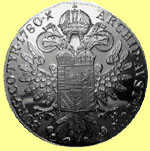
“JD” White coin - obverse |
|
The Austrian
Mint is still making them, even though countries now have their
own currency, and despite major discoveries of silver which
have kept the bullion price low. Records indicate that at least
400 million have been produced since 1780….which means
you can still get one for Dhs. 30 or so in the souks. Which
brings us back to the museum. As both currency and a precious
metal, the thaler was a popular way of holding wealth, either
as coin, or as a source of high-quality silver for ornamentation.
It thus finds its way into jewelry, and as a portable dowry
which a woman could keep close control of. |
|
|
-------------------------------------------------------------------------------------------------------------------------------
| The ENHG
Newsletter…
December, 2004– Issue #223
|
| The
I.Z. Triple Crescent Award Warm-up Hike on Jebel Qatara |
article by Bill Jones,
photos by Mike Green |
|
|
On December 2, a small but enthusiastic group
of hikers met outside the Buraimi Hotel at 7am. We waited
until 7:15 as I had two more names on my list of “definites”.
However, they didn’t show up.
As usual we took the minimum
number of vehicles and were walking up the approach wadi half
an hour later. Our first stop was to look at some pools of
reasonably ”fresh” water. Water was still trickling
into one pool from the base of the rock. Close by were the
remains of a donkey, scavengers had done a good job and very
little remained. Just for a change we decided to follow the
tourist route but made a slight detour near the base of the
plateau. Amongst the boulders we came across the remains of
a shelter. In it were pottery shards, mostly of the ubiquitous
cooking pot, there was a small piece of glazed pottery possibly
from a coffee cup and one piece that from the coarseness and
thickness of clay could possibly have been pre-Islamic. |
| We continued up
and around the back of the plateau at a leisurely pace.
As we walked into the wadi leading onto the plateau we
spotted an Omani lizard (Lacerta jayakari) basking
in the sun. It was about 30 centi-metres long and stayed
around just long enough to have its photo taken. Further
in there were pools of “fresh” looking water.
Interestingly there were no signs of mosquito larvae only
very active water beetles. |
|
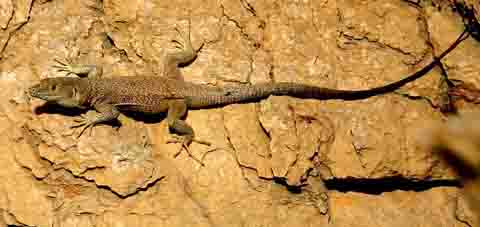 An Omani lizard ( Lacerta jayakari
) basking in the sun.
An Omani lizard ( Lacerta jayakari
) basking in the sun. |
|
After
a short stop for refreshments at the look-out point I showed
the group the fox den on the ledge below. Scrambling back up
we shouldered our packs and moved onto the plateau where we
descended into a couple of the larger wadis. These afforded
fantastic views from where they ended at the plateau’s
edge. From one of them we looked down on the Hanging Gardens.
It was such a beautiful day,
cool and partly cloudy that we decided to walk to the end of
the plateau from where we sat and looked south into Oman. Then
it was time for the return journey. Not wishing to retrace our
steps, as we had done some “interesting” scrambling
on the way up, we had no choice but to go down into a wadi and
up the other side walk along a little way then do it again and
again and again as we traversed the many wadis that carve up
the plateau. Some of the group began to feel tired but they
remained in good spirits and we kept moving at a reason-able
pace. To save time and distance we decided to descend from the
plateau via the “chimney”. Even though only |
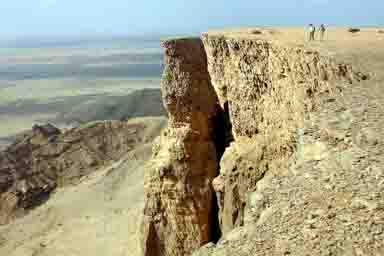 The views are fantastic
The views are fantastic |
|
two of the group had done this before
I felt confident the others could make it as I had watched them
scrambling up some serious rock earlier in the day. I called
a break for refreshments at the top of the “chimney”
before leading them down. At the bottom, the first timers said
they had been apprehensive but now felt very pleased that they
had conquered their fear. Thanks Mike for your invaluable assistance.
Dusk was rapidly approaching so we made haste and got back to
the vehicles with about half an hour of daylight left.
Except for the flies we hadn’t seen much fauna :- a couple
of lizards, a few butterflies a pair of ravens, the occasional
martin, a pair of donkeys with a foal, a flock of pigeons/rock
doves, and a fleeting |
| glimpse of an unidentified raptor. In contrast
the flora was lush and abundant many species in flower with
some of the shrubs setting seed. It had been a long day but
everyone agreed a thoroughly enjoyable one. Thanks Mike, Geoff,
Karen and Wolfgang for your company. |
|
|
--------------------------------------------------------------------------------------------------------------------------------
| The ENHG
Newsletter…
December, 2004– Issue #223
|
|
|
Bioluminescence
Those of you who may visit the East coast beaches
at night will likely witness the extraordinary phosphores-cence
that lays strips of light on the beach and follows
every footstep on wet sand. OK there are some of you
already know what it is but for those who don’t,
read on.
"Another phenomenon, more
often associated with the tropics, is fairly common
around the Greek Islands; this is the "phosphorescent
sea". It is seen at its best on moonless nights
in late August and September and seems, for some reason
or other, to be brightest when a thunderstorm is impending.
Then every splash of the oars, every ripple past bow
or stern, every swirl in the long wake, is outlined
by darting sparkles of greenish fire.
A dive over the boat's side is a thing to be remembered
forever. As you part the velvety black of the waters,
countless millions of green sparks streak past you
like a storm of stars. Minute fiery snow-flakes brush
you in wind-blown flurries until your flesh squirms
with conviction that they must burn you. And auto-suggestion
almost convinces you that they do! The sensation is
so incredibly eerie that, after a few minutes of it,
you generally scramble back into the boat in a hurry.
The cause of all this firework display is a unicellular
ani-malcule, Noctiluca miliaris, shaped like a tiny
translucent cherry. The stalk of the cherry is represented
by a short whip or flagellum with which it propels
itself by rhythmically beating the water. And the
size of this organism, which is sometimes so numerous
it can illuminate many square miles of ocean? Only
one millimeter (1/25th inch) in diameter - just big
enough to be visible to the naked eye."
ISLAND TRAILS © Theodore Stephanides 1973
|
|
Indigo
Now, about Indigo. I mistakenly believed that the
locally occurring species of Indigo were used for
dyeing in places like Izki, which is next to Nizwa.
Sadly, no, Indegofera tinctoria sourced from
India was grown as a crop and that was the plant source
for the dye. I am not aware of any Indigo dyeing still
being carried out in Oman, nor is Mariam Al Dahari
at the National Museum. We would certainly be interested
to know of any survival of the science and art of
Indigo dyeing in the Arabian Peninsula. (for more
on indigo, see web pages:
http://www.aurorasilk.com/info/indigo.shtml http://www.hort.purdue.edu/newcrop/medaro/
factsheets/INDIGO.html
http://www.chriscooksey.demon.co.uk/indigo/
|
| Incense http://saudiembassy.net/Publications/
MagSummer97/symbol.htm
As part of my plan to share information I find about
matters of interest concerning plants I am sure you
will enjoy reading the above web site.
|
|
PHOSPHORESCENT
SEA
(Indian Ocean; December, 1900)
The sun had set behind a greying shroud,
The air was stagnant, and sheet-lightning strayed
In sudden soundless flares from cloud to cloud,
The sea was glazed with a black film of jade,
But as the light seeped slowly from the sky,
It found a brighter focus in the tides
Bursting in sparks along the steamer's sides
As each bow-wave in turn came hissing by ....
Till every fathom of our churning trail
Was lit by swirls of opalescent spray
Spread in an ever-widening fan of light.
And round us dolphins linked in headlong play,
Their flashing forms aflame from snout to tail,
Scrawled scintillating runes against the night.
CITIES OF THE MIND ©
Theodore Stephanides 1972
|
|
| And this from Chris Drew on Agarwood You
may be interested to know that Agarwood, from which
oudh is extracted, has been recently listed on CITES
Appendix II.
Follow this link for more details:
http://www.traffic.org/news/agarwoodexecutivesummary.html |
| The highest tsunami ever reported was 1,719 ft. (524m)
in Alaska, USA, on July 9, 1958. Lituya Bay is a “T”
shaped fiord. A massive landslip occurred at one end of
the “T” and this sent a wave out of the fiord,
wiping out all vegetation to this elevation. The wave
would easily have swamped the Petronas towers of Malaysia
(1,483 ft. – 452 m ). |
|
|
|
---------------------------------------------------------------------------------------------------------------------------------
| The ENHG
Newsletter…
December, 2004– Issue #223
|
| Esfahan
– a traveller’s report |
article
& photos by Louise Lambert |
|
|
|
The Lonely Planet describes the ancient
city of Esfahan as “Iran’s Masterpiece, the
Jewel of Ancient Persia and one of the finest cities in
the Islamic world” and for once, they were not exag-gerating.
I recently visited Esfahan and there is no better place
to feel the peace and tranquility of Islam than in the
Imam Mosque that finds itself in the Imam Khomeini Square.
For avid photo-graphers or anyone wanting to rest in silence,
this Mosque contains a myriad of light, shadows, echoes,
and color in the complete silence of the prayer areas,
sheltered from wind and all outside noise. The mosque
domes, walls, archways, ceilings and passageways are a
brilliant array of blues and yellows on highly stylized
calligraphy ceramic tiles. The inside ceilings are the
same designs found on Persian carpets and all one can
think is “how did they do that - it’s so high
up?”, a question even more perplexing considering
the fact that the Mosque only took 18 years to build.
Once the capital of Iran, the Shah (meaning King) Abbas
I. |
|
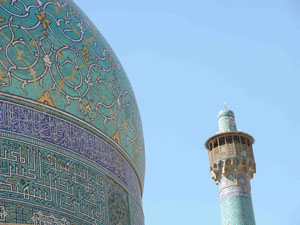 The Imam Ali mosque in Esfahan
The Imam Ali mosque in Esfahan |
|
| ruled
from this palace and welcomed foreign dignitaries. Today, you
can walk circling the Square (half a kilometer in length) enjoying
the surroundding souqs behind all of the Square facades where
Persian silk carpets, chewy gaz (nougat), ceramics, silver works,
and pottery are plentiful. This market place dates back, in
some places, by almost 1300 years. Watch you don’t get
lost in the labyrinth - it is several kilometers long. Local
Irani families outnumber tourists in the late afternoon and
can be seen eating saffron flavored ice-cream (which you really
should try!), smoking sheesha and drinking mint tea from the
cafes, or playing soccer at night in large groups. The grand
fountains in the middle of the Square now replace the polo fields
(polo was invented right in this square) and to watch the sun
set on the minarets of the two mosques and their blue, green,
yellow and gold domes glisten in the setting light during the
call to prayer is the most peaceful way to crown the day. The
air is fresh and clean and a wonderful view of Esfahan in the
distance just flanking the mountains can be seen in the near
distance. The Shah hand picked this location and it’s
not difficult to see why he loved sitting on his royal chair
to watch the local action below and the distant city ahead.
(Also to be noticed is the pink and peach colored ceiling domes
just above and behind where he sat). |
|
|
Esfahan is also famous for its’ bridges
and it has 11 in total, five of them old and worth a visit.
The best time to come is at night where every-one socializes
here on the river. The most lively bridge is the Khaju, built
again by the Abbas (II) dynasty in 1650. It is 132 meters in
length and has two levels of terraces overlooking the river,
where locals and tourists alike come and spend time eating and
drinking tea seated on the ground in large circles, some also
smoking the famous sheesha whose smells waft through the night
air. The lower terrace locks regulate the water level, but when
they are empty (which is almost all the time as the water level
is low and the bridge itself is directly at water level), they
are used as “recording” studios for locals who either
sing, recite poetry, or dance to music in these small chambers
with perfect acoustics. One can walk from one to the other watching
local talent that performs completely unabashedly and undoubtedly
accustomed to performing with an audience. The performance has
not lost its artistic value, there is no money collected and
as a viewer, you are merely noticed and tolerated. If you look
closely, you can notice some built in stone chairs where the
Shah enjoyed his view of the river too. The bridges are lit
with a golden, yellow lights reflecting in the slowness of the
river on both sides. The above terraces are again full of Irani
families with and without children, all walking hand in hand
being the most obvious benefactors of the
|
Beautiful architecture and gardens make Esfahan
world famous. |
|
|
|
-------------------------------------------------------------------------------------------------------------------------------
| The ENHG
Newsletter…
December, 2004– Issue #223
|
| Esfahan
– a traveller’s report cont… |
|
|
restoration
efforts which are evident all over Esfahan. You can buy chai
tea and walk for kilometers along the riverside, day or night
(and yes, holding hands is allowed provided it is your legal
partner) !It is all a very romantic scene and Persian culture,
poetry and romance are all alive and well, even in an Islamic
republic like Iran.
One should not be put off by
the propaganda about Iran. It is worth a visit and you’d
be hard pressed to find more friendly people who frequently
stop you just to say hello and ask where you are from and
if you need assistance of any kind. Iranis are keenly aware
and immensely proud of their culture; Persian roots of literature,
architecture, and art. A history lesson is never far away
if you show any slight glimpse of interest. The Iranis I met
were very curious about what others think of them, knowing
very well what kind of press they attract and their openness
on this subject and many others (their direct questioning
takes a bit of getting used to!) allows you to walk away with
a clearer picture of what Iran and the Revolution are/were
all about.
Women should not at all be worried about traveling in Iran.
The same rules apply as they do in the Gulf, a lone woman
will always be served first and attended to with the utmost
respect and efficiency. As long as your hair is covered and
you have the appropriate clothing, and the no-touch rule is
respected between genders, you can expect your stay to be
like anywhere else.
|
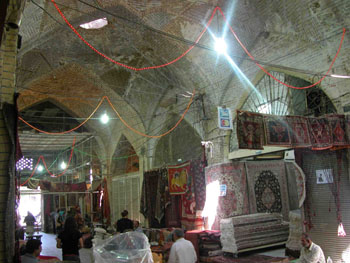
One of Tehran’s many
souqs (bazaars) |
|
|
Tehran on the other hand is not a
place to linger in longer than you must. It is heavily
polluted and crowded, yet has an urban comedic allure
to it. Traffic jams are frequent. On the way to the
airport, we were completely stopped in traffic for over
twenty minutes. Men sat on their hoods smoking cigarettes,
women tying and retying their head scarves, talking
to one another and to the adjacent cars from their open
windows. Yet, it all seems to work somehow and the sense
of community and social respect is not lost in the metropolis.
Cigarettes and shared back and forth and mirrors borrowed,
lipstick reapplied, conversations and laughter flow.
Other times, cars will
skip out of the lane onto the shoulder of oncoming traffic
to avoid the delays and any space seems like a good
enough space to drive on, i.e., curbs, sidewalks, driveways,
escape routes, freeway shoulders. The police actually
stand in the road on the lines to prevent cars
|
|
| from
forming new traffic lanes - which they do anyway once they’ve
passed the police patrols. Nine lanes on a five lane freeway
is typical and seems the only way to get anywhere. The infrastructure
is hopelessly stretched for the booming 14 million Tehranis.
The martyr murals on the walls of drab and gray buildings speak
to the harshness of the Iraq-Iran war. Families commission artists
to paint their men who have died for Iran. They are considered
national heroes, and take their place alongside the only other
allowed murals, giant reproductions of the late Ayatollah Khomeini,
the present Ayatollah Khameini, and the President of the Republic,
Mr. Khatami. The wounds of the Iraqi war are not far behind
and speak to a turbulent not-so distant past that seems to linger
in the gray and congested air of the city. |
|
There are many intellectuals here. Some
trying to understand, making sense of Iran’s place in
the world, and making do with the present order and government,
while others trying to push against the established order
- quietly and not so quietly - others reminiscing about the
pre-Revolutionary days and others, younger, curious about
the world yet perplexed about the world’s reaction to
them, the Revolution being all they have ever known.
The people, the land, both
the wonder and the ordinari-ness of Iranian humanity, are
not to be missed. Intellectually stimulating, it’s like
looking in a fishbowl, at the results of an experiment that
in many ways have worked and in other ways, reflect the many
tangents and permutations that nations and people take and
create to survive and live. A lesson, as all holidays are,
in self-reflection and making sense of ourselves through the
experience of others
|

Tapestries such as this one are important Iranian
products. |
|
|
-------------------------------------------------------------------------------------------------------------------------------
| The ENHG
Newsletter…
December, 2004– Issue #223
|
| Insect
studies –
Mike Gillett’s contribution |
by
Brigitte Howarth |
|
|
Mike has been
in the UAE for 13 years, working as a biochemist at the FMHS,
UAE University. He has contributed greatly to the knowledge
of insects in the UAE. His own favourite group are the beetles
(Coleoptera) although he has also written about moths and
butterflies (Lepidoptera) and many other arthropods. Over
the years Mike has written many articles, describing new records
to the UAE. Recently Mike has intensively studied the largest
beetle that occurs in the UAE, a type of longhorn beetle.
I joined him and his son Conrad (also a coleopterist) on an
early morning beetle watch, and we found three of the desired
beetle, all males. I was on my way to Dubai so took these
with me to show my students. Hence, about 40 students benefitted
from Mike's new collecting technique and the opportunity to
see these beetles alive. A funny twist to the story came that
evening when some folk had gathered at my home, including
Mike and his son Conrad and we remembered the beetles. Fetching
them and the nearest vessel I could find I handed all this
to Mike who let out the beetles to show everyone. As it was
now evening time these nocturnal insects had become very active
and as soon as two were placed together in the vessel I had
provided they began to fight. Mike and Conrad were very pleased
to see this behaviour but were also worried about the beetles
getting damaged so Mike put one on his arm and went to pick
another up when...... lo and behold.. it grabbed his finger,
biting him and drawing blood!!!! Mike shrieked and the vessel,
a glass bowl, went flying through the air, crash-landing with
a clang in a duet between splintering glass and a hurt cry
from Mike! How about that for beetles getting their own back!
In the spirit of Science Mike's first words after his recovery
were: "Well, we've learnt something else about their
behaviour now...". And it is that spirit that we'll all
miss on our field trips and workshop meetings.
As most members will realise, Mike has been collecting and
studying insects during the whole time he has been here and
this has resulted in a reference collection of specimens.
Mike has generously given the Al Ain Chapter of the ENHG this
collection for safe keeping and use. The collection and observations
made by Mike are invaluable and it is our intention to ensure
that the specimens go to a safe permanent home, e.g. a natural
history museum, one of these days. Hours of work have gone
into preparing and curating the hundreds of specimens, and
with it greater knowledge of what occurs in this part of the
world. Everyone hears the mention of biodiversity. Biodiversity
can only be measured once specimens have been recorded and
reported. Mike's collection is important for many reasons,
this being one of them. It is only possible to understand
an ecosystem once all the species that exist within it are
identified. Many insects are primary consumers and together
with the primary producers (plants) form the basis of all
other food chains and food webs. An understanding of what
sustains these food webs makes it possible to understand,
assess and advise on whether developments will have an adverse
impact on animals that are under threat of extinction. Indeed,
many insects are on danger lists due to habitat fragmentation
and contributions such as Mike's are needed to understand
distribution of such species. The Committee is indebted to
Mike for the gift of the collection and together with all
the members and everyone who is likely to benefit from the
collection we would like to express a great big 'thank you'.
We wish you well in your next adventure and look forward to
many visits.
|
________________________________________
Library Notes
We have a substantial library of books, including both
specialist and ‘general interest’ titles. The
library is housed in the ENHG workroom, at Al Ain English
Speaking School.
The full list of titles is on our website.
Whilst some atlases & maps are for reference only, most
of our books can be borrowed by members. All you have to
do is come along on a committee night & browse, or contact
me at the school (767 8631).
Books can be borrowed for one month, and can be returned
on meetings nights, or through one of the committee.
Here are some of the new titles, all donations:-
Emirates Bird Report (Vol. 18)
On the folklore & oral history of the UAE (Zayed Centre
for Heritage & History)
This is me: A hunter & his findings (traveler’s
memoir by Kenneth Guichard)
Natural World of New Zealand (gift from Franz Rudolf Schnitzler,
our visiting speaker in Nov.)
Rough Sheller’s Guide to Northern Emirates
‘Liwa’ – Journal of Centre for Documentation
& Research (in Arabic)
New observations on camels & their milk (Ulrich Wernery)
Archaeology of the UAE ed. Potts (Conference proceedings)
|
|
|
--------------------------------------------------------------------------------------------------------------------------------
| The ENHG
Newsletter…
December, 2004– Issue #223
|
|
|
At our Annual General Meeting this year, Mark
Beech, from ADIAS, gave a presentation on the work being
done on the ancient house & skeleton find on Marawah,
one of the offshore islands of the UAE. This find looks
like the oldest example of ancient civilization in the
UAE. and possibly in the Middle East (7,600 yrs. old).
For more on this, see <http://www.adias-uae.com/>.
|
Rudi Schnitzler (PhD student at Victoria
University in Wellington, New Zealand), has been researching
"habitat fragmentation effects on parasitoid
diversity and tri-trophic interactions." His
presentation was most interesting and well supported
with slides. He presented the ENHG with an illustrated
encyclopedia of the natural history of New Zealand
- a great addition to our library ( see inset).
The lovely thing about this presentation was that
Rudy was on his way back to New Zealand from Germany.
He had spotted our website some time ago and contacted
us to see if there was any interest in his topic.
This is why the website is so important. Thank you
Rudy for both the fine presentation and for expanding
our world.
|
| On December 14th, Dave Clark gave us an
insightful presentation on the water resources of the
UAE and Bangladesh where he has recently beemn working.
members wishing to learn more will just have to wait for
his next presentation. |
| Just a reminder
that the Annual Photo Competition is not that far off.
Check the website for details! |
|
| 12-12 - The UAE's National Clean-up Day was a
great success here in Al Ain. Members showed up
and helped pick up lots of garbage in an area adjacent
to last year's site. Local school children participated
as did local businesses. The ENHG also did a follow-up
weekend clean-up trip for those who wanted to participate,
but who were unable to get away from work during
the cweek. So a group went out to a local oasis/wadi
and picked up trash for 2-1/2 hours. This is our
way of showing our thankfullness for the openness
of all the inhabitants of the oases who welcome
us whenever we tour their areas. Let's make a bigger
effort next year. |
|
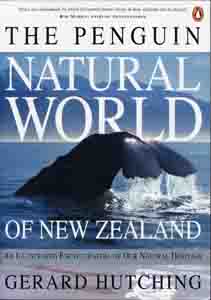 Rudy Shnitzler's contribution to
the ENHG library
Rudy Shnitzler's contribution to
the ENHG library |
|
|
| And finally, but not leastly - on December 30th a group sallied
forth to a location just outside of Ray/Fay on the Hatta road.
The village offered the khaima type rock house with the roof
still in place (though sagging somewhat). We were able to appreciatehow
these structures servered their inhabitants, providing shade,
ventilation, security, privacy and all the necessities of domesticity.
Phil Iddison, a life member, was in Al Ain for just a couple
of days and provided us with an excuse for one last outing.
Buildings were measured, GPS locations were taken. The information
will be written up and a copy provided for the ENHG. |

The khaima style roof used widely throughout
the UAE up until quite recently.
This site was abandoned no more than 25 years ago.and possibly
less. |
Happy
New Year one and all! |
|
|
|




 Setting up the firepit in the
moonlight
Setting up the firepit in the
moonlight 








